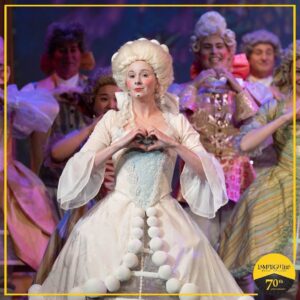By Georges! A Day in the Life of the Legendary Chevalier de Saint-Georges
James D Sasser (Book & Lyrics); Charles Vincent Burwell (Music & Lyrics)
Lamplighters Music Theatre

As with so many accomplished people of color, the incredible life, achievements, and legacy of Joseph Bologne, Chevalier de Saint-Georges, has largely been forgotten since his 1799 death in Paris, France where he left so many marks of fame. As a Creole free man of color, the Chevalier was widely celebrated especially in the pre-Revolutionary years as a French champion fencer, a violinist, and a composer of string quartets, violin concertos, and even operas. To help remedy the Chevalier’s overlooked life, Lamplighters Music Theatre has commissioned James D Sasser (book and lyrics) and Charles Vincent Burwell (music and lyrics) to compose the world premiere operetta, By Georges! Rather than approach the story as a biography, the composers present a whimsical, light-hearted look at A Day in the Life of the Legendary Chevalier de Saint-Georges, much with the same feel, look, and sound of the Company’s normal Gilbert and Sullivan fare and with enough facts gleefully tweaked and twisted to ensure a happy ending is enjoyed by all.
The seventy-five-minute (no intermission) tongue-in-cheek venture into Saint-Georges’ life begins with a lovely, well-presented string quartet by the composer himself with bright, happy notes that vigorously chase each other back and forth as they set the proper mood of the operetta to follow. Famed novelist Alexandre Dumas (Martin T. Bell) – whose father as a General in fact fought alongside Saint-Georges – then sings a somewhat pompous aria to pose the question “Is the pen mightier than the sword? while warning us that the answer will be duly provided even though what we will witness is “fiction.” In other words, sit back; enjoy the fun; but do not write a term paper using what you learn as facts.

However, even in myth there can be much truth that rings forth, with the events of nearly two hundred fifty years ago still resembling the realities of today. Much of this particular day for Saint-Georges is focused on what those of the arts still must constantly do – approach possible donors to solicit their patronage and their funds. Attending the elaborate salon of Madame Sac d’Argent, Saint-Georges finds in her a true lover of him and his profession. Krista Wigle wonderfully conveys through sung frills and flutters the message that “art is for all of us” and that when “music is in the air, it trickles everywhere.” With much drama and exaggerated animation, she comically but convincingly makes the case for supporting artists like Saint-Georges. “It’s the least my family’s fortune from misbegotten sources can do,” she declares just before Stage Director Céline Ricci orchestrates one of several over-the-top, hilarious scenes as the hostess suddenly brings her salon to a sudden, unexpected ending.

Not quite sharing her view of Saint-Georges is Mademoiselle Blanche de Pompeuse as Amy Foote skips through the scales of her area with purposely shrill notes of high soprano to declare that opera must be a “pure and pristine form.” For her, that is a too-not-subtle code meaning a Black man should not be given patronage and certainly not be named to head the Paris Opera (a position the real composer was offered in 1776 but then the offer rescinded when patrons like her objected to his color).
Less concerned of his color and in fact totally smitten with his handsome appearance and the possibility of starring on his stage is the young Lady Lilette Sauverfaire. Leslie Katter uses her lilting soprano voice impressively to make her case that “I’ll sing on your stage” while also not missing a chance to allow her beautiful notes to seduce the attention of the Chevalier toward her arms and her already-pursed lips.

Charles Burwell’s composed arias joyfully and with fun mimic the late eighteenth-century music played in salons and on stages. There is a hint of the likes of Mozart ringing from Mary Chun’s orchestra of twelve and from the notes sung gushingly by the various members of the cast. That includes the briefly sung appearances of three Jeans who arrive with big, colorful bows in their pig-tailed wigs to challenge the famed fencer to three duels. In a laugh-out-loud series of duels, the three (Eric Mellum, Jonathan Spencer, and a disguised Lady Lilette) sing both singly and in a spirited trio as they duel the champion. Of course, there is not one whose cartoonish moves with their rapiers is a match for the almost yawning and clearly smirking Saint-Georges.

The early classical period music that is sung with glitter and glitz by everyone else gives way to a more modern style and feel when the debonair Saint-Georges sings his assigned arias. Omari Tau’s opening aria does sport the period’s style of tripping through notes in staccato style as he describes his life being like that of a dance as he balances his “duels with fools,” his music, and the time he must spend among the aristocracy soliciting funds. But later when he sings an aria of “The Truth in Me,” Omari Tau truly reveals the richness and beauty of his baritone voice as he leaves behind the late 18thcentury and sings more as one might hear on a modern stage.
Throughout, Omari Tau excellently portrays a persona that is almost looking at the scenes around him as an amused, perhaps even superior, third-party observer. Yes, he is always present in body; but he is also clearly not of the same giddy, silly, near-ridiculous natures of those seeking to see and be seen among Paris’ societal apex. We do get the feeling through the Omari Tau’s well-executed, well-directed mannerisms that this man of Creole heritage clearly realizes that amongst all this high-aired, much-feigned hubbub, he is accepted maybe more as an oddity than in any genuine manner.
Much of the production’s enjoyment comes from the delightfully ornate settings as created in both set and projections by Peter Crompton. A rotating table – tilted to alert us that what we are watching is a bit tipsy in truth – turns with the help of three scene-hopping dancers (Kelly Garrett, Paunika Jones, and Zahna Simon) both to shift the stage’s perspectives and to introduce giant projections that lusciously drip in baroque-era color and ostentation. The hilariously towering, multi-curled wigs designed by Arie Singer; the oft-powdered and -rouged make-up of Vanessa Blanchard Lee; and especially the puffy, ribboned, and patterned tucks and pleats of Miriam R. Lewis’ period costumes are the icing on the cake.
And speaking of cakes, nothing is more over-done with great comedic flair than the entrance of Queen Marie Antoinette (Deborah Martínez Rosengaus). Foregoing afternoon English tea, the Queen prefers with her cake “a proper preparation of royal caffeination,” leading to a caffeine-buzzed scene that reminds one of a scene from a Marx Brothers’ movie.
While there is certainly a lot of fun to be had in this world premiere farce where fact and fiction become quite mixed, it feels to me that some arias are too short-changed and that another fifteen or so minutes to the entire production would allow the story of the over-looked Saint-Georges – even one that is highly fictionalized – to be given a bit more time to resonate. What I do appreciate is Artistic Director Cheryl Blalock’s decision to commission a new work in order to expand while still honoring the tradition of the Company’s seventy-year history with Gilbert and Sullivan.
Rating: 4 E
By Georges! A Day in the Life of the Legendary Chevalier de Saint-Georges continues in world premiere performance by Lamplighters Music Theatre, 2 p.m. and 7:30 p.m. May 20 and 2 p.m. May 21 at the Mountain View Center for the Performing Arts, 500 Castro Street, Mountain View. Tickets are available online at https://lamplighters.org or https://tickets.mvcpa.com or by phone at 650-903-6000.
Photo Credits: Joe Giammarco
